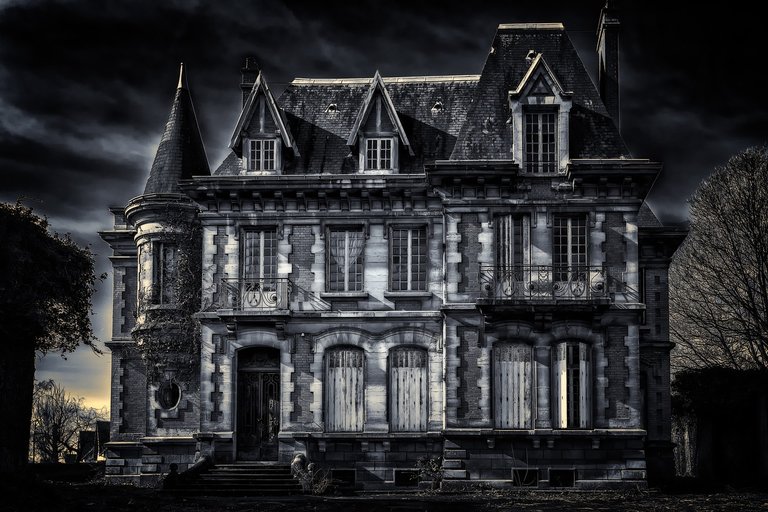There was a girl named Esther who resided in the small town of Salem, found between hills and thick forests with her family, it was so small that everybody knew everybody.
For years, the people of Salem lived in quietness, deliberately avoiding the elephant in the room. It all began with the old, raggedy cottage on the outskirts of the town that once had been a beautiful estate, now covered with darkness and shadows. The natives called it the "Whispering House," not because the house whispered but rather for the silenced conversations and concerning looks that are associated with it.
The house once belonged to the Christopher family, they were the most influential family in Salem. However, about thirty years ago, they became absolutely nothing. Just in a single night, the Christopher family's sudden disappearance sent shivers down everyone's spines, yet it remained a mystery. It resulted in rumors nobody wanted to talk about, let alone bother to utter the words. The house was left untouched. It became a legend no one was willing to investigate.
Among the inhabitants of Salem was Esther Roland, a curious and young schoolteacher. She had always felt awkward about Whispering House but had been told from a young age some things are better off covered than opened. Her mother, a believer in the upholding of peace, instilled this in her daughter. "In Salem," she'd say, "some things are better left untouched." And Esther would reply,
"Ok, mama."
Daily Esther's curiosity kept on increasing. One windy afternoon she decided to take a tour around the abandoned estate. As she walked toward the gate, she saw creeping vines that had almost covered the gate, telling their tale of desertion. Just when she got close to the door, she heard bat noises which made her take to her heels without looking back.
Throughout the evening Esther felt so uncomfortable. She tried to involve her family in the conversation about the old house during dinner, but each time, she received either silence, or she was asked to change the topic of conversation right away. "Esther, let's not have that conversation," her older brother Preston said, one could sense distress in his voice. "The past is the past."
Not one to be left in the dark, Esther took it up on herself to find out as much information as she could about the Christopher family. At the library, Esther found newspapers concerning the sudden disappearance of the Christopher family. Each article she read was written in general terms and almost always ended with "The case remains unsolved."
One rainy afternoon, while Esther was in the library, she stumbled upon an old journal, owned by Mrs. Victoria, housekeeper to the Christopher's, and in the journal, she recorded the final days of the family before their disappearance. The entries with a building tension of fear, strange visitors, and midnight meetings visibly made the family fidget.
Esther's heart beat faster as she read about a late-hour meeting between Mr. Christopher and some dark figure, discussing a "dark secret" and "ensuring its protection." The final entry was suddenly cut off, leaving Esther with more questions than answers.
Determined to unravel the mystery, Esther summoned courage and paid a visit once more to the Whispering House. As she entered it, her flashlight shone brightly on the dusty interior; she could tell it was grand. The silence in the house was indeed relieved only by the occasional creak of the floorboards.
In the study, Esther found an opening in the wall hidden behind the family picture. Documents and letters inside the wall exposed the Christopher family's dark secret: their involvement in an embezzlement scheme in which they looted huge amounts of money from area businesses and charity organizations. The family, scared of being brought to the limelight, had planned to flee because it wouldn't take long for the town to realize that their disappearance was not a case of simple vanishing but, rather, an attempt to escape.
Esther knew the truth was not just about the Christophers but of the denial of the town. Salem had decided to ignore the past and lived in a fog of serenity. They managed the town and hated talking about the past since it would affect their present comfort.
The very next day, Esther brought the issue in front of the town council. All the members of the community were present, one could tell they were curious by the look on their faces. As Esther brought out the documents, she solved the mystery of the whispering house. The truth was exposed, and Salem's image had now been dainted.
Esther's mother, who never supported the idea of looking into the past, looked at her daughter with her eyes beaming with pride. "I didn't want to face it," she said, "but I see now that the truth needed to be out in the open," she continued, "the truth always surfaces, Mom, sooner or later," Esther answered.
After the truth was out, Salem had to face the truth and live with it, the mystery of the whispering house was no longer a mystery but now the truth that lived with everyone and helped them to accept their past.
Esther hadn't just dug up the past but had made Salem realize that it is much more damaging to avoid the truth than to face it. And though the path to healing was long, the vital lesson remained that the truth, no matter how deeply buried, would always find a way to surface.







